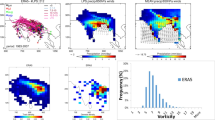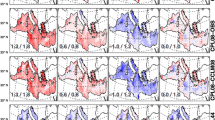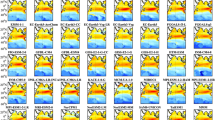Abstract
The turbulent fluxes across the ocean/atmosphere interface represent one of the principal driving forces of the global atmospheric and oceanic circulation. Despite decades of effort and improvements, representation of these fluxes still presents a challenge due to the small-scale acting turbulent processes compared to the resolved scales of the models. Beyond this subgrid parameterization issue, a comprehensive understanding of the impact of air-sea interactions on the climate system is still lacking. In this paper we investigates the large-scale impacts of the transfer coefficient used to compute turbulent heat fluxes with the IPSL-CM4 climate model in which the surface bulk formula is modified. Analyzing both atmosphere and coupled ocean–atmosphere general circulation model (AGCM, OAGCM) simulations allows us to study the direct effect and the mechanisms of adjustment to this modification. We focus on the representation of latent heat flux in the tropics. We show that the heat transfer coefficients are highly similar for a given parameterization between AGCM and OAGCM simulations. Although the same areas are impacted in both kind of simulations, the differences in surface heat fluxes are substantial. A regional modification of heat transfer coefficient has more impact than uniform modification in AGCM simulations while in OAGCM simulations, the opposite is observed. By studying the global energetics and the atmospheric circulation response to the modification, we highlight the role of the ocean in dampening a large part of the disturbance. Modification of the heat exchange coefficient modifies the way the coupled system works due to the link between atmospheric circulation and SST, and the different feedbacks between ocean and atmosphere. The adjustment that takes place implies a balance of net incoming solar radiation that is the same in all simulations. As there is no change in model physics other than drag coefficient, we obtain similar latent heat flux between coupled simulations with different atmospheric circulations. Finally, we analyze the impact of model tuning and show that it can offset part of the feedbacks.
















Similar content being viewed by others
References
Adler RF, Huffman GJ, Chang A, Ferraro R, Xie P, Janowiak J, Rudolf B, Schneider U, Curtis S, Bolvin D, Gruber A, Susskind J, Arkin P, Nelkin EJ (2003) The version 2 Global Precipitation Climatology Project (GPCP) Monthly Precipitation Analysis (1979-Present). J Hydrometeor 4(6):1147–1167
Barnier B (1998) Forcing the Ocean. In: Chassignet J, Verron EP (eds) Ocean modeling and parameterization. Kluwer Academic Publishers, The Netherlands. pp 45–80
Beljaars ACM, Beljaars BACM. 1995. The parametrization of surface fluxes in large-scale models under free convection. Q J R Meteorol Soc 121(522):255–270. https://doi.org/10.1002/qj.49712152203
Bellucci A, Gualdi S, Navarra A (2010) The double-ITCZ syndrome in coupled general circulation models: the role of large-scale vertical circulation regimes. J Clim 23(5):1127–1145
Birol Kara A, Rochford PA, Hurlburt HE, 2000. Efficient and accurate bulk parameterizations of air—sea fluxes for use in general circulation models. J Atmos Ocean Technol 17(10), 1421–1438
Bjerknes J (1969) Atmospheric teleconnections from the equatorial pacific. Mon Weather Rev 97(3):163–172. https://doi.org/10.1175/1520-0493(1969)097<0163:ATFTEP>2.3.CO;2
Blanc TV (1985) Variation of bulk-derived surface flux, stability, and roughness results due to the use of different transfer coefficient schemes. J Phys Oceanogr 15(6):650–669. https://doi.org/10.1175/1520-0485(1985)015<0650:VOBDSF>2.0.CO;2
Cao N, Ren B, Zheng J (2015) Evaluation of CMIP5 climate models in simulating 1979–2005 oceanic latent heat flux over the Pacific. Adv Atmos Sci 32(12):1603–1616
Chahine MT (1992) The hydrological cycle and its influence on climate. Nature 359, 6394, 359(6394):373–380. http://www.u.arizona.edu/~conniew1/geog532/Chahine1992.pdf%5Cnhttp://ntrs.nasa.gov/search.jsp?R=19930026415
Charnock H (1955) Wind stress on a water surface. Q J Roy Meteorol Soc 81:639–640. https://doi.org/10.1029/2004JC002585
Chen D, Busalacchi AJ, Rothstein LM (1994) The roles of vertical mixing, solar radiation, and wind stress in a model simulation of the sea surface temperature seasonal cycle in the tropical Pacific Ocean. J Geophys Res 99(C10):20345. http://rainbow.ldeo.columbia.edu/~dchen/collection-dchen/jgr94.pdf%5Cnpapers3://publication/uuid/162C05ED-3E74-401E-9D41-CA6EE1D24D43
Corrsin S (1975) Limitations of gradient transport models in random walks and in turbulence. Adv Geophys 18(PA):25–60
Covey C, Barron E (1988) The role of ocean heat transport in climatic change. Earth-Sci Rev 24(6):429–445
DeCosmo J et al (1996) Air-sea exchange of water vapor and sensible heat: the humidity exchange over the sea (HEXOS) results. J Geophys Res Oceans 101(C5):12001–12016. https://doi.org/10.1029/95JC03796
Fairall CW et al (2003) Bulk parameterization of air-sea fluxes: Updates and verification for the COARE algorithm. J Clim 16(4):571–591
Fichefet T, Morales Maqueda MA (1999) Modelling the influence of snow accumulation and snow-ice formation on the seasonal cycle of the Antarctic sea-ice cover. Clim Dyn 15(4):251–268
Găinuşă-Bogdan A, Hourdin F, Khadre Traore A, Braconnot P (2018) Omens of coupled model biases in the CMIP5 AMIP simulations. Clim Dyn. https://doi.org/10.1007/s00382-017-4057-3
Held IM, Soden BJ (2006) Robust responses of the hydrological cycle to global warming. J Clim 19(21):5686–5699
Hourdin F et al (2006) The LMDZ4 general circulation model: climate performance and sensitivity to parametrized physics with emphasis on tropical convection. Clim Dyn 27(7–8):787–813
Hourdin F et al (2015) Air moisture control on ocean surface temperature, hidden key to the warm bias enigma. Geophys Res Lett 42(24):10885–10893
Hourdin F et al (2016) The art and science of climate model tuning. Bull Am Meteorol Soc 98. https://doi.org/10.1175/BAMS-D-15-00135.1
Kjellsson J (2015) Weakening of the global atmospheric circulation with global warming. Clim Dyn 45(3–4):975–988
Kossin JP, Vimont DJ (2007) A more general framework for understanding atlantic hurricane variability and trends. Bull Am Meteor Soc 88(11):1767–1781
Kousky VE, Kagano MT, Cavalcanti IFA (1984) A review of the Southern Oscillation: oceanic-atmospheric circulation changes and related rainfall anomalies. Tellus A 36A(5):490–504
Krinner G (2005) A dynamic global vegetation model for studies of the coupled atmosphere-biosphere system. Glob Biogeochem Cycles 19:GB1015. http://www.agu.org/pubs/crossref/2005/2003GB002199.shtml
Kubota M et al (2002) Japanese ocean flux data sets with use of remote sensing observations (J-OFURO). J Oceanogr 58(1):213–225
Large WG, Pond S (1981) Open ocean momentum flux measurements in moderate to strong winds. J Phys Oceanogr 11(3):324–336
Large WG, Yeager SG (2004) Diurnal to decadal global forcing for ocean and sea–ice models: the data sets and flux climatologies. NCAR Tech. Note, TN–460 + ST(May)
Louis JF (1979) A parametric model of vertical eddy fluxes in the atmosphere. Bound Layer Meteorol 17(2):187–202
Madec G et al (1998) OPA 8.1 ocean general circulation model reference manual. Notes du Pôle de Modélisation, Institut Pierre Simon Laplace no 11, p 97
Marti O et al (2010) Key features of the IPSL ocean atmosphere model and its sensitivity to atmospheric resolution. Clim Dyn 34(1):1–26
McGregor S et al. (2014) Recent Walker circulation strengthening and Pacific cooling amplified by Atlantic warming. Nat Clim Change 4(10):888–892. http://www.nature.com/nclimate/journal/v4/n10/full/nclimate2330.html?WT.ec_id=NCLIMATE-201410
Miller MJ, Beljaars ACM, Palmer TN (1992) The sensitivity of the ECMWI? Model to the parameterization of evaporation from the tropical oceans. J Clim 5(5):418–434
Minobe S, Kuwano-Yoshida A, Komori N, Xie S-P, Small RJ (2008) Influence of the Gulf Stream on the troposphere. Nature 452:206–209. https://doi.org/10.1038/nature06690.
Monin AS, Obukhov AM (1954) Basic laws of turbulent mixing in the atmosphere near the ground. Tr Akad Nauk SSSR Geofiz Inst 24:163–187
Potter H, Drennan WM, Graber HC (2017) Upper ocean cooling and air-sea fluxes under typhoons: a case study. J Geophys Res Oceans 122(9):7237–7252
Rayner NA (2003) Global analyses of sea surface temperature, sea ice, and night marine air temperature since the late nineteenth century. J Geophys Res 108(D14):4407. https://doi.org/10.1029/2002JD002670
Redelsperger JL, Guichard F, Mondon S (2000) A parameterization of mesoscale enhancement of surface fluxes for large-scale models. J Clim 13(2):402–421
Saint-Lu M, Braconnot P, Leloup J, Marti O (2016) The role of El Niño in the global energy redistribution: a case study in the mid-Holocene. Clim Dyn. https://doi.org/10.1007/s00382-016-3266-5
Seager R, Blumenthal MB, Kushnir Y (1995) An advective atmospheric mixed layer model for ocean modeling purposes: global simulation of surface heat fluxes. J Clim 8(8):1951–1964
Smith SD (1988) Coefficients for sea surface wind stress, heat flux, and wind profiles as a function of wind speed and temperature. J Geophys Res 93(C12):15467–15472
Stull RB (1988). An introduction to boundary layer meteorology. Kluwer Academic Publishers, Dordrecht
Swenson MS, Hansen DV (1999) Tropical Pacific Ocean mixed layer heat budget: the Pacific cold tongue. J Phys Oceanogr 29(1):69–81
Trenberth KE (1995) Atmospheric circulation climate changes. Clim Change 31(2–4):427–453
Trenberth KE, Stepaniak DP (2004) The flow of energy through the earth’s climate system. Q J R Meteorol Soc 130(603 PART B):2677–2701
Uppala SM et al (2005) The ERA-40 re-analysis. Q J R Meteorol Soc 131:2961–3012
Xie SP (1999) A dynamic ocean-atmosphere model of the tropical Atlantic decadal variability. J Clim 12(1):64–70
Xie S, Philander SGH (1994) A coupled ocean-atmosphere model of relevance to the ITCZ in the eastern Pacific. Tellus A 46(4):340–350
Zeng X, Zhao M, Dickinson RE (1998) Intercomparison of bulk aerodynamic algorithms for the computation of sea surface fluxes using TOGA COARE and TAO data. J Clim 11(10):2628–2644
Acknowledgements
This manuscript is a contribution to the ANR COCOA project (ANR-16-CE01-0007). Computing time was provided by GENCI (gen 2211) on the CURIE CCRT super computer using model. Computing and analysis tools are developed by the IPSL IGCM group. The simulations were performed as part of the DECLIC project (GIS climat DECLIC project). The lead author is supported by a CFR PhD grant of the CEA (Commissariat à l’Enérgie Atomique et aux énergies alternatives).
Author information
Authors and Affiliations
Corresponding author
Rights and permissions
About this article
Cite this article
Torres, O., Braconnot, P., Marti, O. et al. Impact of air-sea drag coefficient for latent heat flux on large scale climate in coupled and atmosphere stand-alone simulations. Clim Dyn 52, 2125–2144 (2019). https://doi.org/10.1007/s00382-018-4236-x
Received:
Accepted:
Published:
Issue Date:
DOI: https://doi.org/10.1007/s00382-018-4236-x




